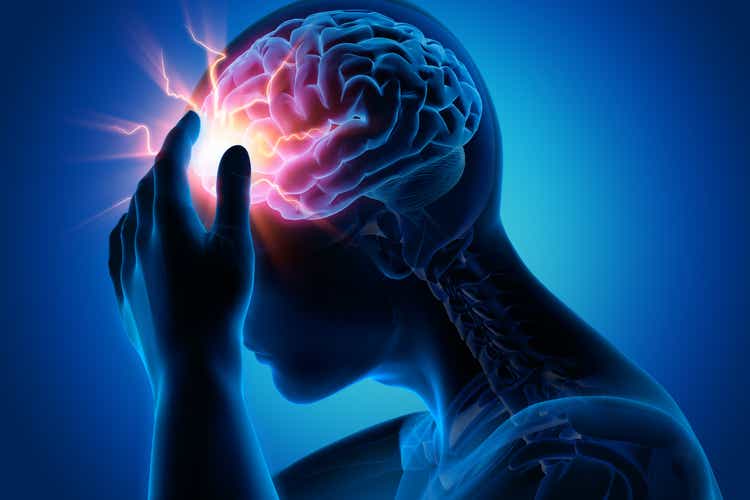peterschreiber.media/iStock via Getty Images
Pain relief has been a notorious rock upon which many drug discovery project have broken and sank. I would not even want to try to count how many, but every once in a while around here I highlight yet another hypothesis that has not worked out. There are of course opiate drugs, which do indeed have profound effects on pain relief, but which (of course) come with huge liabilities. A non-addictive drug that provided such levels of efficacy would be a huge advance, and that’s not even to mention the sorts of pain signal that not even opiates do a sufficient job blocking. There’s massive “unmet medical need” in this area, to use the standard phrase, and always has been.
Over the last twenty years or so there’s been a lot of work directed at various ion channels, with Nav1.7 getting the most attention. That one’s a voltage-gated sodium channel that is very important in nerve transmission, and it’s particularly concentrated in the terminals of what are known to be pain-sensing neurons. Back around 2004, there were several discoveries that created a lot of excitement around this target. It was demonstrated that mice in which that gene was knocked out had much-reduced sensitivity to various sorts of pain, and in humans, several nearly-simultaneous papers showed that a rare human condition characterized by peripheral neuropathic pain (erythromelalgia) was actually a gain-of-function disorder of the same ion channel. Two years later, there was a sensational report of a patient in Pakistan, a man who had a total loss-of-function of Nav1.7 and could not seem to feel pain at all (!) Three related families in Northern Pakistan were then identified with a nonsense mutation in the associated gene.
So putting this all together, you would immediately hypothesize that a small molecule that shut down the function of this ion channel would be quite an extraordinary pain drug. A number of companies started in on that quest – not without realizing the risk, though. There was the brutal history of other pain drugs, of course, and ion channels are known to have quite a few complexities of their own. They can have several small-molecule binding regions, each of which does something different, and sometimes it’s hard to find a decent chemical matter that binds at all. But classic analgesic drug lidocaine seems to work by hitting a number of sodium ion channels, albeit rather nonselectively, so there was some hope that a better compound could be found. Importantly, 1.7 is not found in the central nervous system, only in the periphery (and not in the heart, either), so there was a real possibility of getting pain relief without setting off the addiction pathways.
Here’s a recent review of where all that 1.7 work has led, and here’s one on the sodium channel blockers in general. It isn’t pretty. A whole list of compounds have been discovered (dozens of them for 1.7 alone, if you count the peptides and antibodies as well as the small molecules) and many of these have gone into the clinic (those links will detail them for you). But none of the 1.7 compounds have shown really meaningful efficacy! There are some signs of pain relief, but nothing near what anyone had hoped. So what’s going on? Well, there are actually several related sodium ion channels in those neurons – in addition to 1.7, there are also 1.8 and 1.9, for starters. And it also turns out that those people (and those mice) with inactivating 1.7 mutations have some other unusual features, such as greatly increased levels of enkephalins, the natural ligands for the opioid receptors, and you’re not recapitulating that when you just treat with a compound that hits 1.7 alone. Once again, a genetic knockout gives you a different situation than dosing an acute inhibitor; compensatory mechanisms kick in during a human or mouse’s development, and this has happened many a time. So the story was never as clear as it looked, and the outcomes sure haven’t been what anyone had hoped.
But hope, as we know, springs eternal. Recently, Vertex (VRTX) announced clinical data from a Nav1.8 inhibitor, VX-548, in patients after abdominoplasty or bunionectomy surgery. That ion channel might be even more well-situated to be a good target (in the C-fibers of the dorsal root ganglion), but the relationship of these channels is complex and is still being worked out. 1.8 knockout mice also show very diminished pain response, though, and there’s room to believe that this subtype might also be even more important in human pain signaling. Vertex’s results have not come easily – I believe that this was their fourth Nav1.8 compound to be recommended to the clinic. And these results in particular have some unusual features, particularly that the control group seemed to show less effect of their traditional pain medication (hydrocodone/acetaminophen) than you might have expected. The company is getting a larger trial together, and that one will be closely watched to see how things work out. The efficacy was seen only at the highest dose, so it’ll be interesting to see if the company tries to go up from there.
There’s more than one kind of pain, of course. Painful sensations of cold and heat are different than acute injury pain, and chronic pain is another thing beyond that, with neuropathy being a subset of its own there, too. So VX-548 will also be of great interest to see which of these it might be more (or less) effective for. We’ll learn something about Nav1.8 no matter what, but it would be nice to learn something and be able to offer relief to patients, instead of learning that (once again) we can’t help them…
Disclosure: None
Editor’s Note: The summary bullets for this article were chosen by Seeking Alpha editors.


Be the first to comment